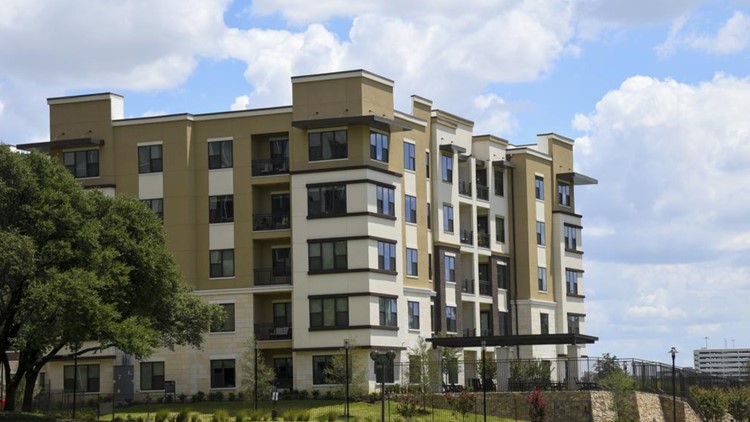DALLAS — One in three apartment seekers now living in Dallas-Fort Worth is looking to leave the DFW Metroplex, according to new data from online rental platform Apartment List.
The Houston, Austin, Oklahoma City and Denver metro areas are the most popular destinations for the 33% of apartment seekers residing in DFW but aiming to move out of the area.
The analysis of renters' apartment-shopping plans gives insight to migration patterns into and out of DFW.
In the inbound direction, 25% of people looking for apartments in DFW are searching from outside the metro area. Houston, Austin and San Antonio provided the most inbound search interest last year.
The analysis is based on millions of Apartment List searches from people who registered for the site in 2022.
As a rule, long-distance movers — those looking for apartments in a new state or new metro area — typically have higher budgets than local renters, showing how recent migration patterns have put upward pressure on rents, according to Apartment List’s Migration Report.
In-state rental hunters typically have 5.5% higher income than locals looking to move within in any given market. Cross-state movers typically have 11.5% higher income.
That puts renters looking to make a move within DFW at a slight disadvantage to renters looking to enter the area from another Texas market and a bigger disadvantage to renters looking to move in from out of state, according to the report.
“This dynamic means that markets experiencing an influx of new renters are likely to face increased affordability challenges,” the report says. “This has been particularly true since the start of the pandemic, as remote work has enabled a surge in domestic migration.”
With 25% of DFW renters coming from outside the metro area, that partially explains why apartment rent prices and occupancy rates remain relatively high in DFW, with year-over-year increases in both categories.
With an overall occupancy rate of 92.2%, DFW leads all major Texas metro areas in occupancy, according to the latest report from ApartmentData.com. That compares to 90.4% occupancy in Houston, 90.3% in Austin, and 89.9% occupancy in San Antonio.
Across DFW, apartment rents increased 6.3% in the past 12 months to a median of $1,491 per month.
In Houston, rents are up 4.6% in the past year to a median of $1,253 a month. Austin rents rose 3% in the past year to a median of $1,625 monthly. San Antonio rose 4% in the same period to $1,201 monthly.
Single-family homebuilding slowing
Meanwhile, DFW homebuilders are pulling back on plans for new development judging by the decline in residential building permits most North Texas cities experienced in the second half of 2022.
The Dallas market had 2,188 single-family home permits approved in December 2022, a 34% decline compared to December 2021, according to the U.S. News Housing Market Index.
Single-family home permits in the Dallas market reached a five-year high in March 2022 with nearly 6,000 approvals and has largely declined since. In the final three months of 2022, there were 7,088 single-family home permits approved, which was down 32% from the same time period in 2021, when 10,570 single-family homes were approved for construction, according to the index.
While single-family home building permits decline, more multifamily is on the way in and around Dallas.
Permits for more than 3,100 multifamily housing units were approved in December 2022 in the Dallas market, an 86% year-over-year increase, the index shows.
In the final three months of 2022, nearly 9,300 units were approved for construction in DFW, up over 70% from the roughly 5,400 permits approved in the final three months of 2021.
National trends for renters
Many renters considered long-distance moves in 2022. Among all Apartment List users nationwide, 40% were searching for apartments in a new metro last year. And 27% were searching for an apartment in a new state.
“Some of this reshuffling is undoubtedly attributable to the long-term adoption of remote work, which offers newfound flexibility to a segment of the workforce that also earns relatively high wages,” the Apartment List report says. “Remote workers moved at higher rates, and recent data suggest they will continue to do so in the near future.”
With affordability waning, a key migration trend during the pandemic has been the movement of renters away from the nation’s most-expensive markets toward more-affordable ones. This dynamic is supported not only by the budget data from Apartment List, but also rent growth trends and official population estimates from the U.S. Census Bureau.
At the state level, Texas has posted the largest population gain in the nation since July 2021, increasing by 470,708 people to a total population of 30,029,572 at the end of 2022, according to the Census data. By crossing the 30-million-population mark, Texas joins California as the only states with a resident population above 30 million.
Growth in Texas since 2021 has been fueled by gains in net domestic migration (230,961 people from other states), net international migration (118,614 people from other countries), and natural increase (118,159 natural born Texans), according to the Census Bureau.



